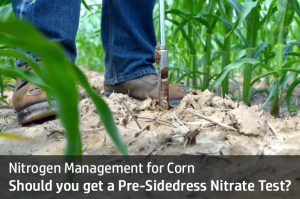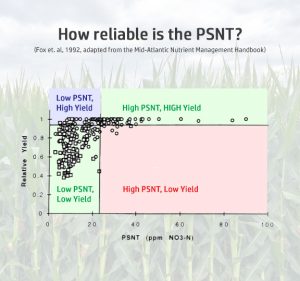Recap: Pre-Sidedress Nitrate Test
If you’ve followed the Delaware-Maryland 4R Alliance on Facebook over the last few weeks, you might have noticed that we linked to several resources on the Pre-sidedress Nitrate Test, or PSNT. Whether you’re looking for information on how to sample for a PSNT or how to interpret the results, or information on the reliability of the test, here’s a recap on the resources that we posted:
About the PSNT

Per the University of Maryland Extension website, “The Pre-sidedress Soil Nitrate Test (PSNT) is a widely used test for optimizing nitrogen fertilizer use for corn grain and corn silage. It is a soil test that measures the amount of nitrate nitrogen available in the soil at the time when the crop is most likely to start using it. This nitrogen is a by-product of the mineralization of manure and/or last year’s forage legume crop, and its availability is influenced by soil temperature and moisture.
The PSNT should be run when corn is between 6 and 12 inches tall. This is the time period when corn is getting ready for a rapid growth spurt and will require nitrogen to fuel this growth. If the PSNT shows enough nitrogen is present in the soil, it may be beneficial to forego the application, thus saving time and money. If the test shows nitrogen is low, it may be beneficial to consider sidedressing additional nitrogen to avoid any potential compromise in yield.”
If you grow corn and have applied manure as a nutrient source, a PSNT can help you refine your in-season nitrogen recommendations.
Marylanders can find guidance here: https://extension.umd.edu/…/pre-sidedress-soil-nitrate-test…
Delawareans should look here: http://extension.udel.edu/…/nitrogen-management-for-corn-i…/
Reliability of the PSNT
 The Pre-Sidedress Nitrate Test has been a trusted tool in the Mid-Atlantic for nearly 30 years. While a lot of things have changed in agriculture over that time, the processes that drive N availability in the soil are still as relevant as they were when the PSNT was first developed.
The Pre-Sidedress Nitrate Test has been a trusted tool in the Mid-Atlantic for nearly 30 years. While a lot of things have changed in agriculture over that time, the processes that drive N availability in the soil are still as relevant as they were when the PSNT was first developed.
The study below evaluated the PSNT in fields in Maryland, Pennsylvania and Delaware. Each dot represents a sample. By far, most samples fall in the green areas of the graph, where the PSNT did its job. The blue area shows non-responsive sites- those areas where additional N did not result in a higher yield. The red area shows the few sites where the corn responded to additional N that the PSNT didn’t recommend.
PSNTs are recommended in Maryland and Delaware on corn acres with a history of manure application and/or legume production.
The Mid-Atlantic Nutrient Management Handbook can be found here. Information about the PSNT is on pages 173-174. Please note that nutrient management guidance issued by your state’s department of agriculture or university extension will have the most up to date information as it applies to regulations in your area.